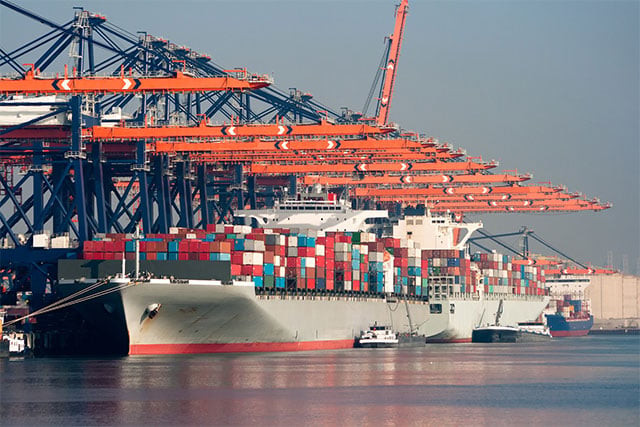The declining trend in Pakistan’s exports
Expected outlook not promising as reported by SBP report

Decline in exports indicates economic emergency in Pakistan. PHOTO: EXPRESS
Total exports were reported at $18 billion between January 2016 and October 2016. This figure is lower than the total exports of $19 billion reported for the corresponding period in 2015. Although, the decline in exports is attributed to a global slowdown in demand, the trend must be investigated as the export base for Pakistan is not only limited to a few products but is mostly confined to low-valued products that are susceptible to price shocks.
US top export, China import destination for Pakistan in 2015
Borrowing data from UN COMTRADE and product classifications from World Integration Trade Solution (WITS), the declining trend in exports is examined below.
The exports from Pakistan are mainly destined for the United States, the European Union and the Middle East, at approximately 24%, 15% and 11% respectively in 2013. Recently, after the negotiation of the free-trade agreement with China in 2007, the exports to China have surged. The European Union awarded the GSP Plus status to Pakistan in 2014, which was aimed at boosting the exports from Pakistan.
The European Union and the United States of America imported approximately 30% and 15% of the global trade in 2013. Their shares have increased slightly between 2013 and 2015. On the other hand, China has maintained its share at approximately 10% of global trade between 2013 and 2015. The three destinations accumulatively account for more than 50% of the total imports.

Similar to the global trend, the share of exports from Pakistan to the United States and the European Union has increased between 2013 and 2015. Pakistan exported more than 30% of its total exports to the European Union in 2015 and 17% to the United States. However, in absolute numbers, exports from Pakistan to the United States have fallen. On the other hand, the value of exports from Pakistan to the European Union has increased between 2013 and 2015, which is likely to be driven by the preferential treatment to Pakistani exports imported under the GSP Plus scheme.
Pakistan exports mainly textile products, vegetable products and leather products, which cumulatively constituted approximately 78% of the total exports in 2015. Their share in total exports from Pakistan increased between 2013 and 2015. The share of textile products in global trade is slightly less than 5%.
Following remittances, Pakistan's exports also fall
Although, China and India are the largest exporters of textile products, the total contribution of textile products is less than 15%. Their share of vegetable products is approximately 2.7% and 1.2% respectively. The combined exports of leather products and vegetable products are less than 10% in both countries.
On further examination of the trend in exports, the total exports of consumer goods, as classified in WITS, to the European Union from Pakistan had increased between 2013 and 2015 by approximately $770 million but the total exports of intermediate goods and raw materials to the European Union had decreased by approximately $400 million.
Consumer goods are primarily finished products such as made-up textile articles, whereas intermediate goods and raw materials, such as cotton yarn and raw cotton respectively, require further processing before being sold as consumer goods. The share of consumer goods to total exports to the European Union from Pakistan increased from 70% in 2013 to 77% in 2015.
A similar trend was observed for total exports from Pakistan in the textile industry. The total exports of consumer products in the textile industry increased by approximately $565 million but the exports of intermediate goods and raw materials decreased by approximately $160 million.
Furthermore, the exports of consumer products in the textile industry to the European Union increased by $747 million. This suggests that the exports of value added consumer products, particularly in the textile industry, to the European Union performed relatively well compared to raw materials and intermediate goods during the last few years as the exporters of consumer goods were more effective in absorbing the demand shock. The exports to the United States from Pakistan decreased across all aforementioned product classifications.
Approximately 67% of all consumer goods exported by Pakistan were destined for the European Union and the United States. This number increases to more than 86% of the consumer goods exported in the textile industry.
Decline in exports indicates economic emergency in Pakistan
Importing countries may adopt stringent requirements to control the quality of their imports. Non-tariff measures (NTMs), such as sanitary and phytosanitary measures on plants and animals as well as technical barriers to trade mainly on non-agricultural goods, imposed by importing countries to restrict sub-standard imports into the country.
Under NTMs, exporters may be required to meet certain guidelines on size, shape and function of a certain product. Several consignments tend to get rejected by the importing countries if the products do not conform to their requirements. This increases the fixed costs to trade for exporters, limiting trade to larger exporters, who can afford the costs associated with the NTMs.
The developed and advanced countries, such as the European Union and the United States, tend to impose higher levels of NTMs on imports from developing countries, particularly where sub-standard products are prevalent. Therefore, trade policies should ensure that trade obstacles due to NTMs are reduced so that new exporters can participate in international trading activities.
It is imperative to pursue industrial and trade policies that promote value addition within Pakistan. Such a strategy should involve a focus on the exports of consumer goods to their more important destination markets. This will ensure a reduction in the volatility of exports.
The writer is an Assistant Professor of Economics & Research Fellow at CBER, IBA
Published in The Express Tribune, January 2nd, 2017.
Like Business on Facebook, follow @TribuneBiz on Twitter to stay informed and join in the conversation.


















COMMENTS
Comments are moderated and generally will be posted if they are on-topic and not abusive.
For more information, please see our Comments FAQ